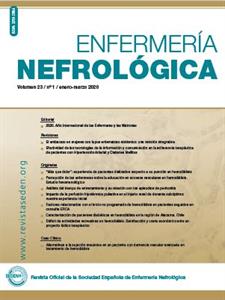Contenido del artículo principal
Resumen
Descripción del caso: Varón de 90 años en tratamiento de hemodiálisis desde el año 2009 a través de Fistula arteriovenosa autológa en brazo izquierdo. En el 2018 comienza con deterioro cognitivo que finalmente diagnostican como demencia vascular avanzada. En las sesiones de hemodiálisis presenta desconexión del medio, agitación psicomotriz llegando en ocasiones a agresiones verbales e intentos de extracción de las agujas. Descripción del plan de cuidados: Se realiza una valoración focalizada inicial para determinar la comorbilidad, mortalidad, el estado cognitivo y el grado de dependencia para las actividades de la vida, posteriormente aplicamos los diagnósticos de enfermería según la taxonomía NANDA con sus respectivos NIC y NOC. Evaluación del plan: Durante el mes de diciembre del 2018 y enero de 2019, se valoró durante 24 sesiones el estado del paciente, para priorizar el uso de sujeción física o abordaje terapéutico alternativo, recurriendo a la musicoterapia, acompañamiento emocional, escucha activa y distracción audiovisual para disminuir la agitación psicomotriz. Las medidas alternativas a la sujeción física disminuyeron los episodios de agitación psicomotriz durante el tratamiento hemodiálisis. Conclusiones: El papel de enfermería es fundamental para evitar sujeción física innecesarias. La única indicación para el uso de sujeción física se debería contemplar cuando existe el riesgo de interrupción del tratamiento, comprometiendo la seguridad del paciente. En el caso clínico presentado, las intervenciones alternativas a la sujeción física disminuyeron la agitación psicomotriz durante las sesiones de HD.
Palabras clave
Detalles del artículo
Derechos de autor 2020 Marta Del Vas García, Elena Cahuancama, Carolina Palomar, Montserrat Cerro, Marta Quintela, María del Transito Suárez

Esta obra está bajo una licencia internacional Creative Commons Atribución-NoComercial 4.0.
Aviso de derechos de autor/a
© Los autores ceden de forma no exclusiva los derechos de explotación de los trabajos publicados y consiente en que su uso y distribución se realice con la Licencia Creative Commons Atribución - No comercial 4.0 Internacional (CC BY-NC 4.0). Puede consultar desde aquí la versión informativa y el texto legal de la licencia. Esta circunstancia ha de hacerse constar expresamente de esta forma cuando sea necesario.
Referencias
- Gil Nieto D, Perera Díaz M, Sevane Fernández L. Estado cognitivo del paciente de edad avanzada en programa de hemodiálisis. Rev Soc Esp Enferm Nefrol 2010;13(1):30-5. DOI: https://doi.org/10.4321/S1139-13752010000100005
- Sánchez Lamolda MA, Malagón Rodríguez MA, Alonso Hernández N. Incidencias de las demencias en hemodiálisis. Apoyo al cuidador principal. Enferm Nefrol 2013;16(1):31-5. DOI: https://doi.org/10.4321/S2254-28842013000100005
- Fundación Cuidados Dignos. Cómo se eliminan las sujeciones. Guía para la eliminación de sujeciones físicas y químicas en centros de atención socio sanitaria y domicilios. Zaragoza: El Justicia de Aragón; 2011.
- Estévez Ramos R, Basset Machado I, Guerrero Lara M, López Vázquez J, Leal García M. La sujeción del paciente con agitación psicomotriz. Enf Neurol (Mex) 2011;10(1):32-8.
- Ashcraft L, Bloss M, Anthony WA. Best practices: The development and implementation of “no force first” as a best practice. Psychiatr Serv. 2012;63(5):415-7. DOI: https://doi.org/10.1176/appi.ps.20120p415
- Corral Cano J. Contenciones físicas: reflexión sobre su vigencia. [Trabajo Fin de Grado] Santander: Universidad de Cantabria; 2014. [Consultado 05 mar 2019]. Disponible en: https://repositorio.unican.es/xmlui/bitstream/handle/10902/5581/CorralCanoJ.pdf?sequence=1&isAllowed=y.
- Burgueño A, Heras C. Centros libres de sujeciones físicas: un estándar de oro de calidad. Rev. Arg. de Gerontología y Geriatría; 31(3):77-82.
- Asociación Profesional de Enfermeras de Ontario (RNAO). Guía de Buenas Prácticas Clínicas. Fomento de la seguridad: alternativas al uso de contenciones. Toronto (ON): Registered Nurses´ Association of Ontario; 2012.
Referencias
Gil Nieto D, Perera Díaz M, Sevane Fernández L. Estado cognitivo del paciente de edad avanzada en programa de hemodiálisis. Rev Soc Esp Enferm Nefrol 2010;13(1):30-5. DOI: https://doi.org/10.4321/S1139-13752010000100005
Sánchez Lamolda MA, Malagón Rodríguez MA, Alonso Hernández N. Incidencias de las demencias en hemodiálisis. Apoyo al cuidador principal. Enferm Nefrol 2013;16(1):31-5. DOI: https://doi.org/10.4321/S2254-28842013000100005
Fundación Cuidados Dignos. Cómo se eliminan las sujeciones. Guía para la eliminación de sujeciones físicas y químicas en centros de atención socio sanitaria y domicilios. Zaragoza: El Justicia de Aragón; 2011.
Estévez Ramos R, Basset Machado I, Guerrero Lara M, López Vázquez J, Leal García M. La sujeción del paciente con agitación psicomotriz. Enf Neurol (Mex) 2011;10(1):32-8.
Ashcraft L, Bloss M, Anthony WA. Best practices: The development and implementation of “no force first” as a best practice. Psychiatr Serv. 2012;63(5):415-7. DOI: https://doi.org/10.1176/appi.ps.20120p415
Corral Cano J. Contenciones físicas: reflexión sobre su vigencia. [Trabajo Fin de Grado] Santander: Universidad de Cantabria; 2014. [Consultado 05 mar 2019]. Disponible en: https://repositorio.unican.es/xmlui/bitstream/handle/10902/5581/CorralCanoJ.pdf?sequence=1&isAllowed=y.
Burgueño A, Heras C. Centros libres de sujeciones físicas: un estándar de oro de calidad. Rev. Arg. de Gerontología y Geriatría; 31(3):77-82.
Asociación Profesional de Enfermeras de Ontario (RNAO). Guía de Buenas Prácticas Clínicas. Fomento de la seguridad: alternativas al uso de contenciones. Toronto (ON): Registered Nurses´ Association of Ontario; 2012.




